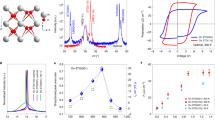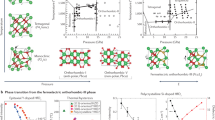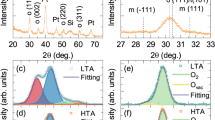Abstract
HfO2, a simple binary oxide, exhibits ultra-scalable ferroelectricity integrable into silicon technology. This material has a polymorphic nature, with the polar orthorhombic (Pbc21) form in ultrathin films regarded as the plausible cause of ferroelectricity but thought not to be attainable in bulk crystals. Here, using a state-of-the-art laser-diode-heated floating zone technique, we report the Pbc21 phase and ferroelectricity in bulk single-crystalline HfO2:Y as well as the presence of the antipolar Pbca phase at different Y concentrations. Neutron diffraction and atomic imaging demonstrate (anti)polar crystallographic signatures and abundant 90°/180° ferroelectric domains in addition to switchable polarization with negligible wake-up effects. Density-functional-theory calculations indicate that the yttrium doping and rapid cooling are the key factors for stabilization of the desired phase in bulk. Our observations provide insights into the polymorphic nature and phase control of HfO2, remove the upper size limit for ferroelectricity and suggest directions towards next-generation ferroelectric devices.
This is a preview of subscription content, access via your institution
Access options
Access Nature and 54 other Nature Portfolio journals
Get Nature+, our best-value online-access subscription
$29.99 / 30 days
cancel any time
Subscribe to this journal
Receive 12 print issues and online access
$259.00 per year
only $21.58 per issue
Buy this article
- Purchase on Springer Link
- Instant access to full article PDF
Prices may be subject to local taxes which are calculated during checkout




Similar content being viewed by others
Data availability
Source data for the main paper figures are provided with this paper. Additional data are available from the corresponding authors upon request.
References
Fan, Z., Chen, J. & Wang, J. Ferroelectric HfO2-based materials for next-generation ferroelectric memories. J. Adv. Dielectr. 06, 1630003 (2016).
Choi, J. H., Mao, Y. & Chang, J. P. Development of hafnium based high- k materials—a review. Mater. Sci. Eng. Rep. 72, 97–136 (2011).
Robertson, J. High dielectric constant oxides. Eur. Phys. J. Appl. Phys. 28, 265–291 (2004).
Mistry, K. et al. A 45nm logic technology with high-k+metal gate transistors, strained silicon, 9 Cu interconnect layers, 193nm dry patterning, and 100% Pb-free packaging. In Proc. 2007 IEEE Int. Electron Devices Meet. 247–250 (2007).
Müller, J. et al. Ferroelectricity in yttrium-doped hafnium oxide. J. Appl. Phys. 110, 114113 (2011).
Böscke, T. S., Müller, J., Bräuhaus, D., Schröder, U. & Böttger, U. Ferroelectricity in hafnium oxide thin films. Appl. Phys. Lett. 99, 102903 (2011).
Polakowski, P. & Müller, J. Ferroelectricity in undoped hafnium oxide. Appl. Phys. Lett. 106, 232905 (2015).
Cheema, S. S. et al. Enhanced ferroelectricity in ultrathin films grown directly on silicon. Nature 580, 478–482 (2020).
Müller, J. et al. Ferroelectricity in HfO2 enables nonvolatile data storage in 28 nm HKMG. In Proc. 2012 Symp. on VLSI Technology 25–26 (2012).
Ali, T. et al. High endurance ferroelectric hafnium oxide-based FeFET memory without retention penalty. IEEE Trans. Electron Devices 65, 3769–3774 (2018).
Martin, D. et al. Downscaling ferroelectric field effect transistors by using ferroelectric Si-doped HfO2. Solid-State Electron. 88, 65–68 (2013).
Hoffmann, M. et al. Direct observation of negative capacitance in polycrystalline ferroelectric HfO2. Adv. Funct. Mater. 26, 8643–8649 (2016).
Khan, A. I. et al. Negative capacitance in a ferroelectric capacitor. Nat. Mater. 14, 182–186 (2015).
Ohtaka, O. et al. Phase relations and volume changes of hafnia under high pressure and high temperature. J. Am. Ceram. Soc. 84, 1369–1373 (2001).
Sang, X., Grimley, E. D., Schenk, T., Schroeder, U. & LeBeau, J. M. On the structural origins of ferroelectricity in HfO2 thin films. Appl. Phys. Lett. 106, 162905 (2015).
Wei, Y. et al. A rhombohedral ferroelectric phase in epitaxially strained Hf0.5Zr0.5O2 thin films. Nat. Mater. 17, 1095–1100 (2018).
Huan, T. D., Sharma, V., Rossetti, G. A. & Ramprasad, R. Pathways towards ferroelectricity in hafnia. Phys. Rev. B 90, 064111 (2014).
Barabash, S. V. Prediction of new metastable HfO2 phases: toward understanding ferro- and antiferroelectric films. J. Comput. Electron. 16, 1227–1235 (2017).
Grimley, E. D., Schenk, T., Mikolajick, T., Schroeder, U. & LeBeau, J. M. Atomic structure of domain and interphase boundaries in ferroelectric HfO2. Adv. Mater. Interfaces 5, 1701258 (2018).
Müller, J. et al. Ferroelectricity in simple binary ZrO2 and HfO2. Nano Lett. 12, 4318–4323 (2012).
Mueller, S. et al. Ferroelectricity in Gd-doped HfO2 thin films. ECS J. Solid State Sci. Technol. 1, N123–N126 (2012).
Mueller, S. et al. Incipient ferroelectricity in Al-doped HfO2 thin films. Adv. Funct. Mater. 22, 2412–2417 (2012).
Bohra, F., Jiang, B. & Zuo, J.-M. Textured crystallization of ultrathin hafnium oxide films on silicon substrate. Appl. Phys. Lett. 90, 161917 (2007).
Lomenzo, P. D. et al. Ferroelectric Si-doped HfO2 device properties on highly doped germanium. IEEE Electron Device Lett. 36, 766–768 (2015).
Katayama, K. et al. Orientation control and domain structure analysis of {100}-oriented epitaxial ferroelectric orthorhombic HfO2-based thin films. J. Appl. Phys. 119, 134101 (2016).
Liu, K. et al. Investigation of phase transformation in HfO2 ferroelectric capacitor by means of a ZrO2 capping layer. In Proc. 2019 IEEE Int. Conf. on Electron Devices and Solid-State Circuits 1–3 (2019).
Chiu, Y.-C., Cheng, C.-H., Chang, C.-Y., Tang, Y.-T. & Chen, M.-C. Investigation of strain-induced phase transformation in ferroelectric transistor using metal-nitride gate electrode. Phys. Status Solidi Rapid Res. Lett. 11, 1600368 (2017).
Materlik, R., Künneth, C., Falkowski, M., Mikolajick, T. & Kersch, A. Al-, Y-, and La-doping effects favoring intrinsic and field induced ferroelectricity in HfO2: a first principles study. J. Appl. Phys. 123, 164101 (2018).
Pešić, M. et al. Physical mechanisms behind the field-cycling behavior of HfO2-based ferroelectric capacitors. Adv. Funct. Mater. 26, 4601–4612 (2016).
Mittmann, T. et al. Origin of ferroelectric phase in undoped HfO2 films deposited by sputtering. Adv. Mater. Interfaces 6, 1900042 (2019).
Materlik, R., Künneth, C. & Kersch, A. The origin of ferroelectricity in Hf1-xZrxO2: a computational investigation and a surface energy model. J. Appl. Phys. 117, 134109 (2015).
Park, M. H. et al. Ferroelectricity and antiferroelectricity of doped thin HfO2-based films. Adv. Mater. 27, 1811–1831 (2015).
Schroeder, U., Hwang, C. S. & Funakubo, H. Ferroelectricity in Doped Hafnium Oxide: Materials, Properties and Devices (Woodhead Publishing, 2019).
Batra, R., Huan, T. D., Jones, J. L., Rossetti, G. & Ramprasad, R. Factors favoring ferroelectricity in Hafnia: a first-principles computational study. J. Phys. Chem. C 121, 4139–4145 (2017).
Shimizu, T. et al. The demonstration of significant ferroelectricity in epitaxial Y-doped HfO2 film. Sci. Rep. 6, 32931 (2016).
Mimura, T., Shimizu, T. & Funakubo, H. Ferroelectricity in YO1.5-HfO2 films around 1 μm in thickness. Appl. Phys. Lett. 115, 032901 (2019).
Shimura, R. et al. Preparation of near-1-μm-thick {100}-oriented epitaxial Y-doped HfO2 ferroelectric films on (100)Si substrates by a radio-frequency magnetron sputtering method. J. Ceram. Soc. Jpn 128, 539–543 (2020).
Hoffmann, M. et al. Stabilizing the ferroelectric phase in doped hafnium oxide. J. Appl. Phys. 118, 072006 (2015).
Park, M. H. et al. A comprehensive study on the structural evolution of HfO2 thin films doped with various dopants. J. Mater. Chem. C. 5, 4677–4690 (2017).
Kisi, E. H., Howard, C. J. & Hill, R. J. Crystal structure of orthorhombic zirconia in partially stabilized zirconia. J. Am. Ceram. Soc. 72, 1757–1760 (1989).
Lee, C.-K., Cho, E., Lee, H.-S., Hwang, C. S. & Han, S. First-principles study on doping and phase stability of HfO2. Phys. Rev. B. 78, 012102 (2008).
Greene, J. E. A review of recent research on the growth and physical properties of single crystal metastable elemental and alloy semiconductors. J. Vacuum Sci. Technol. B 1, 229–237 (1983).
Ito, T. et al. Laser-diode-heated floating zone (LDFZ) method appropriate to crystal growth of incongruently melting materials. J. Cryst. Growth 363, 264–269 (2013).
Kudoh, Y., Takeda, H. & Arashi, H. In situ determination of crystal structure for high pressure phase of ZrO2 using a diamond anvil and single crystal X-ray diffraction method. Phys. Chem. Miner. 13, 233–237 (1986).
Stacy, D. W. & Wilder, D. R. The yttria-hafnia system. J. Am. Ceram. Soc. 58, 285–288 (1975).
Chen, H. et al. Obvious ferroelectricity in undoped HfO2 films by chemical solution deposition. J. Mater. Chem. C 8, 2820–2826 (2020).
Mimura, T., Shimizu, T., Katsuya, Y., Sakata, O. & Funakubo, H. Thickness- and orientation-dependences of Curie temperature in ferroelectric epitaxial Y doped HfO2 films. Jpn. J. Appl. Phys. 59, SGGB04 (2020).
Böscke, T. S. et al. Phase transitions in ferroelectric silicon doped hafnium oxide. Appl. Phys. Lett. 99, 112904 (2011).
Olsen, T. et al. Co-sputtering yttrium into hafnium oxide thin films to produce ferroelectric properties. Appl. Phys. Lett. 101, 082905 (2012).
Schenk, T. et al. Complex internal bias fields in ferroelectric hafnium oxide. ACS Appl. Mater. Interfaces 7, 20224–20233 (2015).
Schenk, T. et al. Electric field cycling behavior of ferroelectric hafnium oxide. ACS Appl. Mater. Interfaces 6, 19744–19751 (2014).
Grimley, E. D. et al. Structural changes underlying field-cycling phenomena in ferroelectric HfO2 thin films. Adv. Electron. Mater. 2, 1600173 (2016).
Reyes-Lillo, S. E., Garrity, K. F. & Rabe, K. M. Antiferroelectricity in thin-film ZrO2 from first principles. Phys. Rev. B 90, 140103 (2014).
Park, M. H., Lee, Y. H., Mikolajick, T., Schroeder, U. & Hwang, C. S. Thermodynamic and kinetic origins of ferroelectricity in fluorite structure oxides. Adv. Electron. Mater. 5, 1800522 (2019).
Lee, H.-J. et al. Scale-free ferroelectricity induced by flat phonon bands in HfO2. Science 369, 1343–1347 (2020).
Toby, B. H. EXPGUI, a graphical user interface for GSAS. J. Appl. Crystallogr. 34, 210–213 (2001).
Acknowledgements
The experimental work was performed at the Centre for Quantum Materials Synthesis (cQMS), funded by the Gordon and Betty Moore Foundation’s EPiQS initiative through grant no. GBMF6402, and by Rutgers University. Neutron diffraction studies used resources at the Spallation Neutron Source, a Department of Energy Office of Science User Facility operated by the ORNL. We thank Q. Zhang from the ORNL for support with neutron diffraction measurements. Y.Q., S.S. and K.M.R. were supported by the Office of Naval Research (grant no. N00014-17-1-2770). The DFT calculations performed for this study used the resources provided by the High-Performance Computing Modernization Office of the Department of Defense and the Rutgers University Parallel Computing clusters.
Author information
Authors and Affiliations
Contributions
X.X. and S.-W.C. conceived the idea. X.X. synthesized the single crystals, collected the XRD data and tested the ferroelectric properties. F.-T.H. took the optical microscope pictures and conducted the TEM experiments. Y.Q., S.S. and K.M.R. performed the DFT calculations. D.O. and J.Y. carried out the neutron diffraction experiments and refinement. F.-T.H. and M.-W.C performed the STEM experiments. X.X., F.-T.H., Y.Q., S.S., K.M.R. and S.-W.C. wrote the manuscript.
Corresponding author
Ethics declarations
Competing interests
The authors declare no competing interests.
Additional information
Peer review information Nature Materials thanks Thomas Mikolajick and the other, anonymous, reviewer(s) for their contribution to the peer review of this work.
Publisher’s note Springer Nature remains neutral with regard to jurisdictional claims in published maps and institutional affiliations.
Supplementary information
Supplementary Information
Supplementary Figs. 1–11, Discussion, Methods, Table 1 and refs. 1–6.
Source data
Source Data Fig. 1
Source data of XRD.
Source Data Fig. 2
Source data of NPD.
Source Data Fig. 3
Source data of P–E loop.
Source Data Fig. 4
Source data of DFT energy landscape.
Rights and permissions
About this article
Cite this article
Xu, X., Huang, FT., Qi, Y. et al. Kinetically stabilized ferroelectricity in bulk single-crystalline HfO2:Y. Nat. Mater. 20, 826–832 (2021). https://doi.org/10.1038/s41563-020-00897-x
Received:
Accepted:
Published:
Issue Date:
DOI: https://doi.org/10.1038/s41563-020-00897-x
This article is cited by
-
Ferroelastically protected reversible orthorhombic to monoclinic-like phase transition in ZrO2 nanocrystals
Nature Materials (2024)
-
Transistors with ferroelectric ZrXAl1−XOY crystallized by ZnO growth for multi-level memory and neuromorphic computing
Communications Materials (2024)
-
Tunable and parabolic piezoelectricity in hafnia under epitaxial strain
Nature Communications (2024)
-
Exploring the role of TiN electrodes in the formation of ferroelectric HfxZr1-xO2 thin films through transmission electron microscopy
Journal of the Korean Ceramic Society (2024)
-
Interface-engineered ferroelectricity of epitaxial Hf0.5Zr0.5O2 thin films
Nature Communications (2023)



